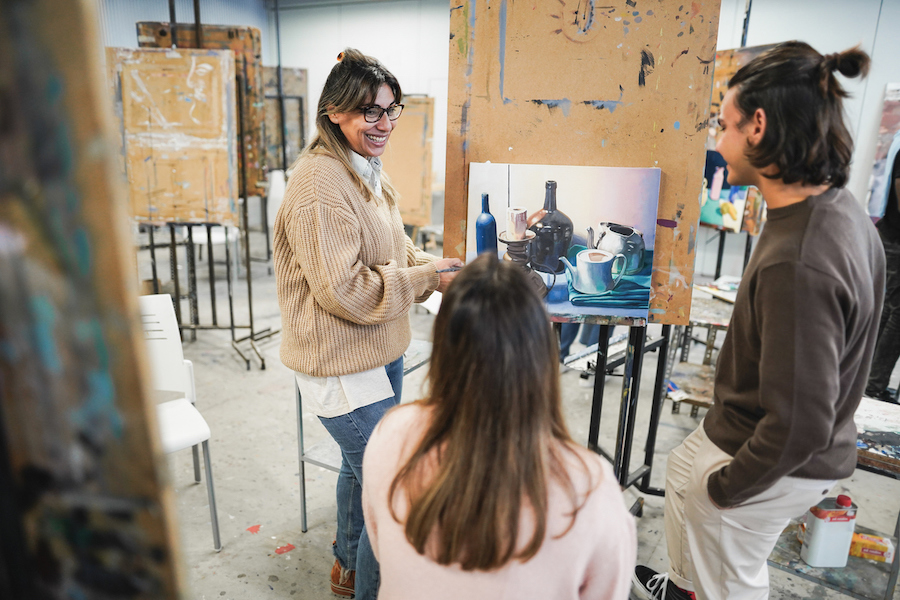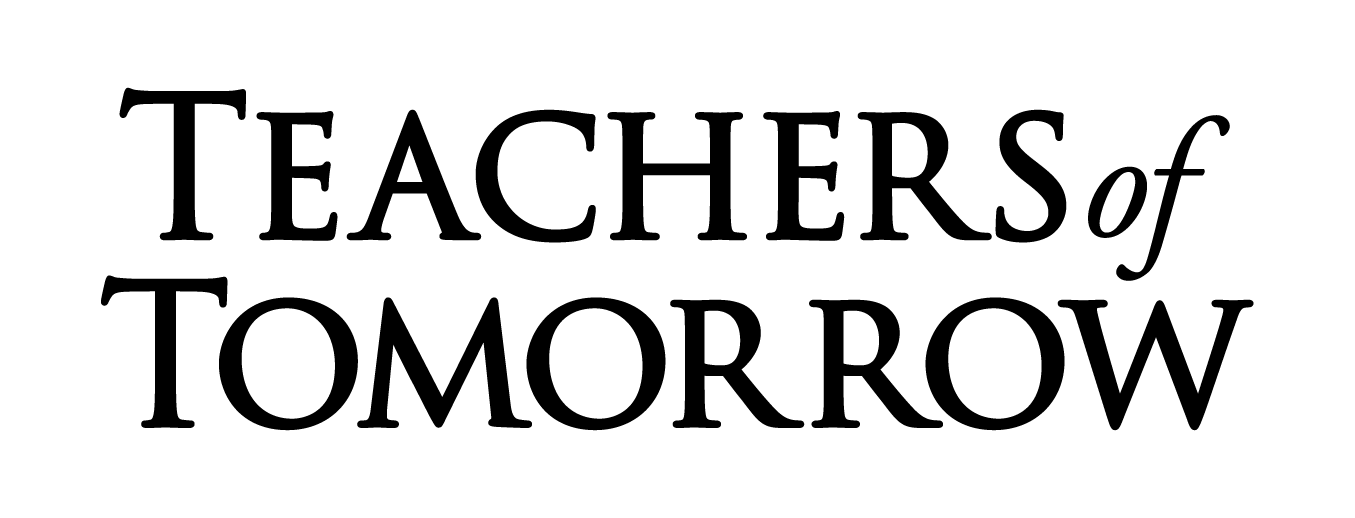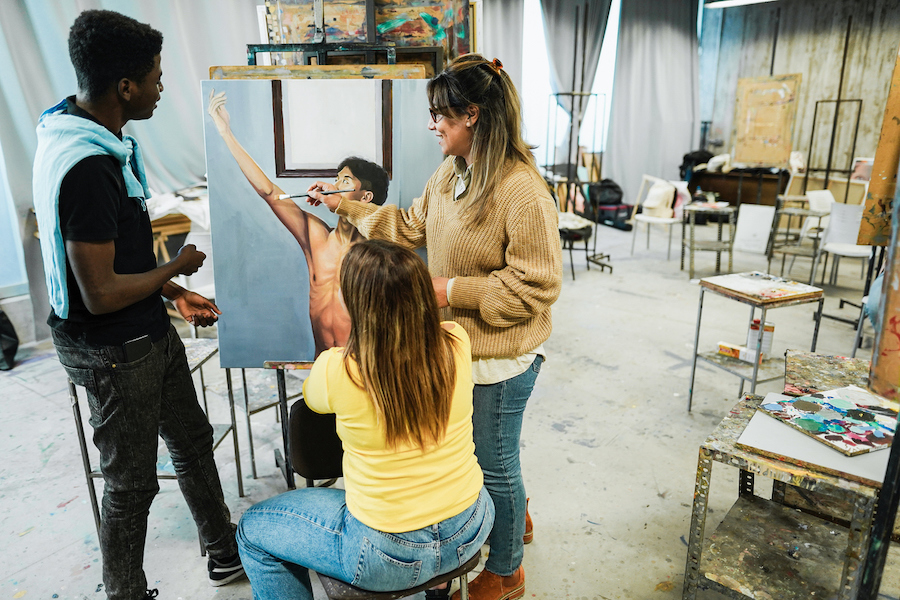Art teachers work with students, teaching them how to paint, draw, take photographs, and create ceramics and sculptures. They design engaging art curricula that align with educational standards– planning lessons, selecting appropriate materials, and building projects that encourage creativity.
As an art teacher, you’ll teach fundamental art concepts and techniques, such as color theory, perspective, composition, and various artistic mediums such as painting, drawing, sculpture, and more.
Art teachers also facilitate students’ acquisition of art supplies, equipment, and sources for art technique instructors according to their competence level.
Teaching art is an exciting opportunity to contribute meaningfully to society while increasing self-awareness and earning a stable income. We have compiled an exhaustive step-by-step guide on how you can join this exciting career, the skill requirements, and the benefits.

Art Teacher Job Definition
Art teachers help students learn how to express themselves creatively. This can be through practical activities such as painting, pottery, photography, sculpturing, drawing, and textiles.
Besides helping students develop artistic skills, they also meet their academic and emotional needs. Art teachers are involved in the general responsibilities of teachers, such as grading and monitoring their educational progress.
Art Teacher’s Responsibilities
As an art teacher, you introduce students to the formal qualities of art and varied media or artistic creation. You also help them become accustomed to the tools and materials they will use in illustrative, sculptural, and craft-based art.
As an art teacher, you’ll be expected to:
- Develop level-suitable learning activities: The art education curriculum should meet students’ interests and abilities. For instance, short-term activities with easy-to-use materials are ideal for younger students, while time-consuming projects such as sculpturing and painting suit older art students.
- Sparking enthusiasm and talent in your students: Encouraging creativity and artistic expression helps students grow their love for art as an emotional outlet and a possible career path.
- Introducing art technique: This includes skills like sketching, shading, and brush strokes. You help learners master these techniques to present their artistic work better.
- Introducing concepts: Through lessons and projects, you introduce art concepts such as types of lines, symbols, and color relationships to students.
- Offering critique: In higher levels of learning, art educators critique students’ work to develop a more profound sense of analysis and improve their art.
- Monitoring progress and awarding grades include establishing grading criteria and providing parents with student progress reports.
How to Become an Art Teacher
As an art teacher, your role involves introducing students to various art forms, nurturing their creative abilities, and fostering their appreciation for artistic expression. Passion for art alone is not enough. Several steps lead to your initial art teaching license.
Traditionally, becoming an art teacher involves the following steps:
1. Choose Your Certification Path
There are two routes you can take to become an Art teacher. These include:
University Route
If you go the traditional university route, you will need to obtain a bachelor’s degree in Art Education or a related field, which typically takes four years. During your degree program, you’ll take courses in art theory, history, and methods, along with general education courses.
Alternative Certification Program
If you have a bachelor’s degree in a field that is not education, programs like Teachers of Tomorrow, can help you become certified without going back to school for a four-year degree.
Instead, you take certification-specific coursework online. The benefits of the alternative certification program include:
- You can complete your certification process in less time than a university degree.
- Alternative certification programs are more affordable than a traditional degree program.
- The programs are more flexible with on-demand learning from home, allowing you to balance work and studies.
- You can gain field experience while still working, helping you to earn money while completing your certification.
2. Pass State-Specific Certification Exams
Whichever path you take, you’ll need to pass specific exams required by your state. The type of exam varies depending on the state, so it’s essential to confirm which one applies to your state.
Here are a few examples:
- TExES: If you intend to teach in Texas, you’ll need to take the Texas Examinations of Educator Standards (TExES) exam, which includes an art content exam.
- NES Art Exam: Assesses knowledge in art foundations, media, historical and cultural contexts, aesthetics, and art criticism.
- Praxis Art Content Knowledge Exam: Evaluates art history, theory, and creation, testing both practical and theoretical knowledge.
The exam tests areas such as:
- Art History: Examines knowledge of major art periods, movements, and influential artists throughout history. It also assesses understanding of art’s relationship to cultural, social, and historical contexts.
- Art Theory: Tests comprehension of fundamental art elements, design principles, and critical analysis approaches. This includes understanding visual components, composition techniques, and methods for interpreting artwork.
- Art Creation and Use: Evaluates practical skills in various art mediums and understanding of the creative process. It also assesses knowledge of effective art teaching methods and strategies.
3. Complete Classroom Training and Teaching Experience
If you’re taking the university route, you complete a student teaching program as part of your degree program. You’ll spend several months in a classroom under the guidance of a mentor teacher.
Through the alternative certification program, you’ll complete a field experience component while actively teaching. This hands-on experience happens alongside your online coursework, which allows for the immediate application of learning in a real classroom setting.
3. Apply for the State License
The state teaching license certifies that you have met the educational and professional requirements to teach in a public school.
To get your license, you’ll need to complete an application form provided by your state’s education department. You’ll then submit supporting documents, including transcripts, proof of student teaching, exam scores, and an application fee.
Most states conduct background checks to ensure you have no criminal records that would disqualify you from teaching.
4. Compile an Art Portfolio
An art portfolio displays your best artwork and showcases your art versatility. In your portfolio, include your finished artwork, sketches, and working documents showing your creative process.
Arrange your images in a narrative flow, with the best of your works in the first and last images. Include a variety of images within your areas of specialization.
5. Apply for Art Teaching Positions
Once your portfolio is ready, it is time to apply for those teaching positions. First, identify a school that offers art education and values art.
Many school districts have dedicated job boards where they advertise teaching vacancies. Use education-specific job boards like the National Art Education Association (NAEA).
Also, contact art teachers in your target areas to learn about the job market and potential opportunities. Participate in art education conferences to network with professionals and explore job openings.
Highlight your teaching experience, qualifications, and relevant skills. Customize it for each application. Tailor your cover letter to each school, emphasizing how your skills and experience align with their specific needs and goals.
Lastly, consider the learning level of the learners you would like to teach and are qualified to teach and apply to join the field of art as a teacher.
Required Skills for Art Teachers
As an art teacher, having different skill sets is crucial for inspiring creativity and fostering artistic growth among students. Here are some essential skills for art teachers :
- Art knowledge: You need to have skills in various artistic mediums. Although your interest may be in a particular area, knowledge in multiple mediums will make you a more effective teacher. For instance, you should be able to guide students through creating 3-dimensional objects with clay, drawing, and painting. Exposing students to a wide range of art mediums will help them to choose a medium when it’s time to specialize correctly.
- Artistic techniques: Artistic techniques are the specific methods and skills you’ll use to create art. They include painting techniques such as perspective, sculpting techniques such as carving, and other skills related to composition, color usage, and materials. As an art teacher, mastering these techniques allows you to translate your ideas and emotions into visual forms. You’ll be expected to visually demonstrate various artistic methods to your students, providing them with clear examples and guidance. When you showcase your expertise in a particular method, you provide students with a clear and tangible example.
- Classroom management: Art classes need to be closely monitored, especially with younger learners. You should be able to grab the learners’ attention and keep them focused on the task at hand, even when they’re excited. Good classroom management skills ensure your students remain engaged, on-task, and focused during art lessons. You’ll often demonstrate techniques and explain project steps as an art teacher. Effective management keeps students attentive, allowing them to absorb your guidance.
Professional Development
Engaging in continuous professional development is crucial for staying current with new techniques, tools, and teaching methodologies.
Today, you can easily learn to teach art. With the availability of books, training courses, free online teaching courses, and university programs, art teachers can grow their skills.
In addition, continuous professional development helps you enhance your creative skills, which can elevate your teaching skills to greater heights.
Student Learning
Student learning is the process through which your students acquire knowledge, skills, attitudes, and behaviors, enabling them to understand art.
Your students need thorough guidance through each art step because art is a process. You should identify suitable creative approaches that draw the attention of less attentive learners and help them identify captivating entry points to the lesson.
Reasons to Become an Art Teacher
Creating art is magical. Becoming an art teacher allows you to inspire children. You make a difference in society by developing critical thinkers, creators, and decision-makers.
You help your learners become better risk-takers by nurturing a brave space in your studio, and they appreciate failure as a positive learning experience.
Teaching offers excellent job security once you have worked hard and earned the certificates. Finally, it offers excellent job security since the flexibility in mobility allows one to teach almost anywhere in the world.
Let’s look at other reasons to become an art teacher
Salary Expectations
Art teachers’ salaries vary depending on the grade taught, the years of experience, the type of school, and the geographical location.
According to the Bureau of Labor Statistics, the median salary for elementary art teachers is $63,680, while middle school art teachers earn a median salary of $63,280. The lowest 10 percent earned less than $45,650, and the highest 10 percent earned more than $100,390.
Job Outlook
The U.S. Bureau of Labor Statistics predicts that elementary, middle, and high school job opportunities will rise by 4% from 2019-2029.
Even when there’s a decline in funding for art in public schools, charter schools provide an excellent opportunity for art teachers.
Additionally, the employment of high school teachers is expected to grow, showing little or no change from 2022 to 2032. However, about 67,100 openings for high school teachers are projected each year, on average, over the decade.
Tips on How to Be a Successful Art Teacher
Building a successful career in teaching demands that you are always open to learning. Look at every failure or gap in knowledge as an opportunity to learn. We have researched some tips that successful art teachers swear by. These include:
Foster Ideas Instead of Just Applying Teaching Techniques
As art is about creativity, teaching art requires that you model creative ways of thinking and playfully interact with the content. This allows learners to work with your ideas to create art creatively.
As an art teacher, you should be aware of your limitations and embrace creative dimensions for your learners to emulate.
Ignite Empathy
Creating a compassionate, empathetic environment helps your learners to connect with you. They will be free to display their creativity and be open to new risks and challenges.
Also, an accepting environment will give them the confidence to make and learn from mistakes.
Advocate for Your Students
As an art teacher, you are the number one advocate for your student’s work. You can do this by sharing their work with the administrators and shareholders. This will make them appreciate the role of art in the lives of these students, compelling more support.
Be an Art Leader to Your Students
Being an art leader to your students requires that you are open to connecting and listening to your students. Lead them by challenging the status quo, encourage them to venture into new creative and innovative spaces, and help them grow through it.
You also must encourage your learners by letting them critique your work, creating boldness and confidence in their art skills.
Feed Your Creativity First
Developing creative and innovative students requires that you are a knowledgeable teacher. Creative teachers are knowledgeable in other areas.
Feeding your creativity involves continually learning new skills and art dimensions that grow your learner’s confidence in you. Taking up an artistic hobby, such as learning a musical instrument, is a great way to start.
Take the Next Step to Your Art Teaching Career
Teaching art helps you develop creativity and innovation as you help students approach problems with different solutions. You encourage mistakes and experimentation, developing your students’ autonomy and independence.
By joining this adventurous career, you can stimulate young people’s imagination and grow their cognitive and problem-solving skills.
Also, as an art teacher, you play with art supplies all day; what an exciting way to spend your day while being paid for it.
Getting teacher certification in teaching art is essential since it gives you a better chance of getting employed in public schools and many art institutions. Certification gives you confidence and shows that you have met the requirements to become an art teacher.




